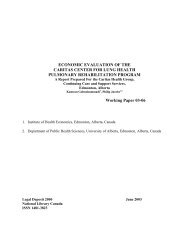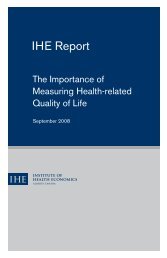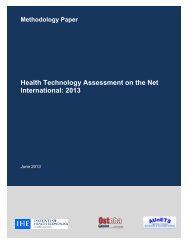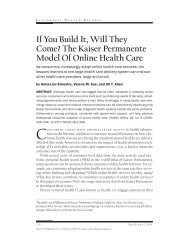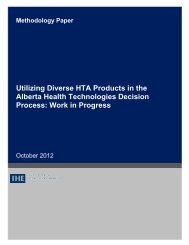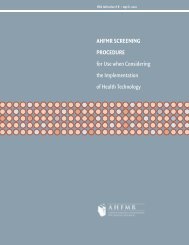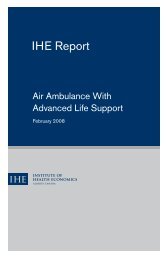Bariatric treatments for adult obesity - Institute of Health Economics
Bariatric treatments for adult obesity - Institute of Health Economics
Bariatric treatments for adult obesity - Institute of Health Economics
- No tags were found...
Create successful ePaper yourself
Turn your PDF publications into a flip-book with our unique Google optimized e-Paper software.
Results from two trials with 100 patients did not reveal any significant difference in incidence <strong>of</strong>post-operative readmission between RYGB and AGB groups.Reoperations and revisionsTwo trials with 248 patients found that, when compared with the RYGB group, the AGB group hadmore late failed surgeries (conversions and reversals); however, no significant differences wererevealed in rates <strong>of</strong> early/late reoperation and reversals between the RYGB and the AGB group.Comparing open to laparoscopic RYGB and VBG, four trials with 286 patients found no significantdifference in incidence <strong>of</strong> early reoperation and three trials with 233 patients found no significantdifference in incidence <strong>of</strong> late reoperation.One trial with 69 patients did not find any significant difference in incidence <strong>of</strong> late reversal betweenopen and laparoscopic AGB.Gastrointestinal disturbancesSixteen trials reported incidences <strong>of</strong> dumping syndrome, dyspepsia, dysphagia, gastritis, reflux, ulcer,or vomiting. There were significantly fewer late ulcers in the AGB group than in the RYGB group.No direct comparisons <strong>for</strong> other AEs were available <strong>for</strong> AGB, RYGB, or sleeve gastrectomy.Five clinical trials involving 556 patients reported the incidence <strong>of</strong> reflux, ulcer, or vomiting. Thepatients with open surgeries experienced significantly less vomiting. No other results weresignificantly different in comparing laparoscopic and open surgeries.Surgical complicationsCompared to RYGB groups, AGB groups had a significantly lower risk <strong>of</strong> early wound infection,late stenosis, and late hernia, but a significantly higher risk <strong>of</strong> late slippage or dilatation. No trialsreported the comparative incidence <strong>of</strong> myocardial infarction.Eight trials involving 694 patients reported the incidence <strong>of</strong> anastomotic leak, bowel obstruction,hernia, respiratory failure, staple-line breakdown, luminal stenosis, wound infection, or venousthromboembolic disease. Compared to open surgeries, laparoscopic surgeries were associated withsignificantly fewer incidents <strong>of</strong> early wound infection and late hernias, but significantly higherincidents <strong>of</strong> late luminal stenosis.In summary, compared to RYGB patients, AGB patients had significantly shorter hospital stays anda lower risk <strong>of</strong> early wound infection, late ulcers, late stenosis, and late hernia, but had a higher risk<strong>of</strong> late slippage or dilatation and late failed surgeries (conversions and reversals).Compared to open surgery patients, those who received laparoscopic surgery had significantlyshorter hospital stays and fewer incidents <strong>of</strong> early wound infection and late hernias, but hadsignificantly higher incidents <strong>of</strong> late luminal stenosis and experienced more vomiting. No differenceswere observed in reoperation and revision rates between laparoscopic and open surgeries.No trials reported the comparative incidence <strong>of</strong> myocardial infarction following bariatric surgeries.Neither the incidence rates <strong>of</strong> the above-noted AEs nor the timeframe <strong>for</strong> their occurrence werereported in this review.<strong>Bariatric</strong> <strong>treatments</strong> <strong>for</strong> <strong>adult</strong> <strong>obesity</strong> 79



